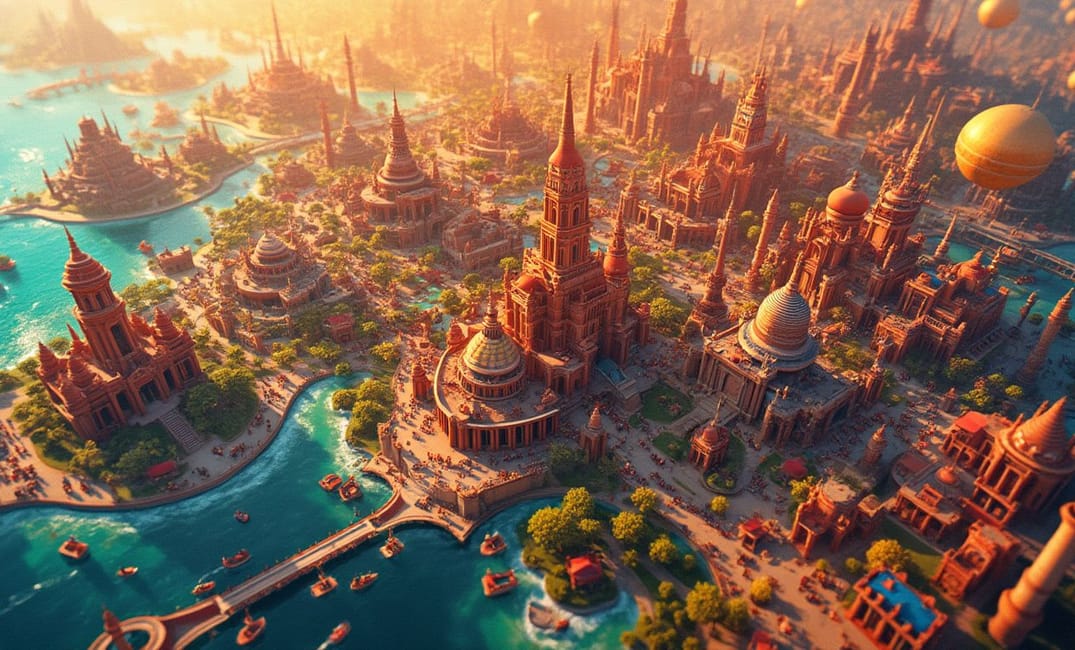Introduction: Weaving the Tapestry of Civilization
Human civilization is a symphony composed of myriad interactions, robust innovations, and vivacious inspirations. These harmonious, yet sometimes discordant elements have shaped societies, driving them toward remarkable achievements and profound transformations. This entry examines the intricate tapestry of human civilization, tracing the chords of cultural exchange, scientific discovery, artistic expression, and philosophical evolution, which continue to resonate through time, cascading into our shared future.
Cultural Interactions: The Fusion of Ideas
Bridging Continents Through Trade and Exchange
- Silk Road: The Artery of Culture: The Silk Road was not just a trade nexus but a vibrant corridor for cultural exchange. Caravans carried silk, spices, and precious metals, while also conveying philosophies, religions, and artistic influences that culturally enriched civilizations across Asia, Europe, and Africa.
- Cross-Cultural Dialogues: Merchant and diplomatic exchanges ignited dialogues that diversified art, language, and science. These interactions spurred technological advancements and political dynamics, leading to epochs of flourishing creativity and knowledge, evident in structures like mosques, temples, and cathedrals showcasing architectural synthesis.
The Age of Empires and Ideas
- The Hellenistic World: Following Alexander the Great's conquests, Greek culture synthesized with Persian, Egyptian, and Indian elements, forming the Hellenistic world. This blend fostered advances in mathematics, astronomy, and philosophy, leaving legacies of critical thought and artistic innovations that persist in modern scholarship.
- The Islamic Golden Age: Flourishing under peaceful trade and scholarly pursuits, the Islamic Golden Age became a beacon of intellectual synergy, where scholars translated classical works and expanded theories in medicine, algebra, and astronomy, integrating diverse cultural influences into cohesive advancements.
Innovations: Driving Forces of Progress
Technological Journeys
- From Wheel to Aeronautics: The invention of the wheel and subsequent technological breakthroughs—such as wind-driven machines, steam engines, and internal combustion—transformed human mobility and urban landscapes, ultimately leading to the powered flight that connected continents in mere hours.
- The Digital Revolution: Beginning in the latter half of the 20th century, the digital revolution reshaped communication, computation, and information dissemination, leading to Internet development, personal computing, and unprecedented data access that continue to redefine contemporary society and economy.
Scientific Renaissance
- The Scientific Method: Pioneers like Newton, Galileo, and Copernicus ushered an era where empirical observations and mathematical rigor became the bedrock of scientific inquiry. This methodological framework accelerated discoveries that shifted worldviews, from celestial dynamics to the fundamentals of chemistry and physics.
- Biological Breakthroughs: The post-enlightenment period saw breakthroughs in understanding living systems. From Darwinian evolution to the discovery of DNA, these insights not only transformed medicine and agriculture but also deepened ethical considerations of humanity's role within nature's complex web.
Artistic Inspirations: A Chorus of Human Expression
Echoes from Antiquity
- The Classical Chorus: Art and literature from ancient China, India, Greece, and Rome established enduring foundations, with epics like "The Iliad" and "The Ramayana" echoing themes of heroism, fate, and human ethics, inspiring artists for millennia.
- Cultural Mahabharatas: Civilizations across oceans crafted complex mythologies and dramas reflected in grand frescoes and intricate tapestries, preserving history and eliciting timeless reflections on morality, purpose, and identity, seen in Renaissance retellings and adaptations across the globe.
Modern Refractions
- Impressionist and Expressionist Waves: Artists like Monet and Van Gogh diverged from realism to capture subjective impressions and emotional resonances, ushering movements that challenged conventional aesthetics and community norms, paving pathways for surrealism and abstract expressionism.
- Digital Art and Visual Nexus: The digital age has transformed artistic creation and curation, with multimedia employing virtual realities and artificial intelligence to explore new dimensions and perspectives, expanding collaborative potentials and redefining creation itself.
Philosophical Evolutions: The Mind's Symphony
Contributions of Eastern and Western Thought
- Confucian Dialogues and Western Rationalism: Eastern philosophies like Confucianism enriched societal ethics with concepts of mindfulness and collective well-being, while Western thinkers implored reason and individualism, concurrently shaping governance, justice, and human rights discourse.
- The Enlightenment’s Ripple: The Enlightenment championed critical humanism and skepticism. Philosophers like Locke and Voltaire provoked dialogues that upended societal hierarchies, fostering democratic ideals and the notion of universal egalitarianism that continue to guide contemporary sociopolitical structures.
Philosophical Innovations in the Modern Age
- Existentialism and Humanism: Modern existential and humanistic philosophers posed fundamental questions of existence, choice, and authenticity in a rapidly commodifying world. Their works underscored themes of individual freedom and responsibility amidst mechanized uncertainties, influencing literature, psychology, and political theory.
- Interdisciplinary Philosophies: Today's philosophers explore integrated perspectives, drawing from cognitive science, environmental ethics, and information theory to address complexities in contemporary global societies, suggesting new narratives for balancing technological advancement with holistic human fulfillment.
Conclusion: The Ever-Evolving Symphony
The symphony of human civilization is an evolving harmony of vibrant interactions, ingenious innovations, and inspirational expressions. It serves as a timeless testament to humanity's boundless curiosity, creativity, and resilience. As we continue to chart unknown futures, embracing diversity and fostering collaborative curiosity remain essential. In this ongoing composition, each note and chord shaped by past civilizations enriches the present, and inspires generations to orchestrate future legacies that can resonate across cosmic horizons forever.
"Human civilization is a symphonic journey transcending time’s confines, a grand tapestry composed of inquisitive minds and creative souls, endlessly exploring the boundless realms of possibility." — *Author Unknown*
HISTORICAL TRANSFORMATIONS, CREATIVE ADVANCEMENTS, HUMAN CIVILIZATION, SCIENTIFIC DISCOVERIES, MODERN THOUGHT, GLOBAL SOCIETIES, TECHNOLOGICAL INNOVATIONS, ARTISTIC EXPRESSION, CULTURAL EXCHANGE, PHILOSOPHICAL EVOLUTION

